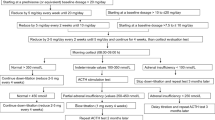Abstract
The administration of corticosteroids by various routes in the treatment of croup remains controversial as studies with varying designs and outcome measures have reported conflicting results. However, meta-analysis supports the use of steroids in croup. A dose equivalent to or greater than 100 mg/kg body weight of hydrocortisone, administered orally or parenterally appears to be effective. Nebulized budesonide in a dose of 1,000 micrograms, when dosages are given 30 minutes apart is also effective. The L-epinephrine is as effective as racemic epinephrine and should be used to relieve symptoms with or without steroids. Summarizing the value of beta agonists, for treatment of bronchiolitis is rather challenging. Beta agonists offer significant relief to only a subgroup of infants, with bronchiolitis, albeit, it remains a challenge to identify these infants prospectively. Availability of RSV immune globulin for prevention of RSV disease in highrisk infants and better defining the role of ribavirin for selected patients may offer additional avenues to the treating physician.
Similar content being viewed by others
References
Kairys SW, Olmstead EM, O’connor GT. Steroid treatment of Laryngotracheitis: A meta-analysis of the evidence from randomized trials.Pediatr 1989; 83: 683–693.
Landau LI, Geelhoed GC. Editorials. Aerosolized steroids for croup.N. Engl J. Med 1994; 331: 322–323.
Husby S, Agertoft L, Mortenson S, Pedersen S. Treatment of croup with nebulized steroid (budesonide): A double blind placebo controlled study.Arch Dis child 1993;68: 352–355.
Klassen TP, Feldman ME, Watters LKet al. Nebulized budesonide for children with mild to moderate croup.N Engl J Med 1994; 331: 285–289.
Klassen TP, Watters LK, Feldman MEet al. The efficacy of nebulized budesonide in dexamethasone-treated outpatients with croup.Pediatr 1996; 97: 463–466.
Kuusela AL, Vesikari T. A randomized, double-blind, placebo controlled trial of dexamethasone and racemic epinephrine in the treatment of croup.Acta Pediatr Scand 1988;77: 99–104.
Miller-Larsson A, Brattsand R. Topical antiinflnmmatory activity of the glucocorticoid on airway mucosa. Evidence for a “hit and run” type of activity.Agents Actions 1990; 29: 127–129.
Duval D, Durant S, Homo-Delarche F. Nongenomic effects of steroids. Interactions of steroid molecules with membrane structures and functions.Biochem Biophys Acta 1983; 737: 409–442.
Brown PH, Teelucksingh S, Matusiewicz SP: el al. Cutaneous vasoconstrictor response to glucocorticoids in asthma,Lancet 1991; 337: 576–580.
Melby JC. Systemic corticosteroid therapy: Pharmacology and endocrinologic considerations.Ann Intern Med 1974; 81: 505.
Ledwith CA, Shea LM, Mauro RD. Safety and efficacy of nebulized racemic epinephrine in conjunction with oral dexamethasone and mist in the outpatient treatment of croup.Ann Emerg Med 1995; 25: 331–337.
Geelhoed GC, Macdonald WBG. Comparison of oral and inhaled steroids in the treatment of croup.Am J Respir Crit Care Med 1994; 149: A375, abstract.
Fitzgerald D, Mellis C, Johnson Met al. Nebulized budesonide as effective as nebulized adrenaline in moderately severe croup.Pediatr 1996; 97:722–725.
Waisman Y, Klein BL, Boenning DAet al. Prospective randomized, double blind study comparing L-epinephrine and racemic epinephrine aerosols in the treatment of laryngotracheitis (croup).Pediatr 1992; 89: 302–306.
Tsai-Goodman B, Chambers TL. Bronchodilators for bronchiolitis.Lancet 1993; 341: 1380.
Reijonen T, Korppi M, Pitkakangas Set al. The clinical efficacy of nebulized racemic epinephrine and albuterol in acute bronchiolitis.Arch Pediatr Adolesc Med 1995; 149: 686–692.
Coupe MO, Guly U, Brown E, Barnes PJ. Nebulized adrenaline in acute severe asthma: comparison with salbutamol.Eur J Respir Dis 1987; 71 : 227–232.
Wang EL, Milner AR, Allen U, Maj H. Bronchodilators for treatment of mild bronchiolitis: a factorial randomized trial.Arch Dis Child 1992; 67: 289–293.
Schuh S, Canny G, Reisman JJet al. Nebulized albuterol in acute bronchiolitis.J Pediatr. 1990; 117: 633–637.
Soto ME, Sly PD, Uren Eet al. Bronchodilator response during acute viral bronchiolitis in infancy.Pediatr Pulmonol 1985; 2: 85–90.
Sanchez I, De Coster J, Powel REet al. Effect of racemic epinephrine and salbutamol on clinical score and pulmonary mechanics in infants with bronchiolitis.J Pediar 1993; 122: 145–151.
Klassen TP, Rowe PC, Sutcliffe Tet al. Randomized trial of salbutamol in acute bronchiolitis.J. Pediatr 1991; 118: 807–811.
Mallory GB Jr, Motoyama EK, Koumbourlis ACet al. Bronchial reactivity in infants in acute respiratory failure and with viral bronchiolitis.Pediatr Pulmonol 1989; 6: 253–259.
Hammer J, Numa A, Newth C. Albuterol responsiveness in infants with respiratory failure caused by respiratory syncytial virus infection.J. Pediatr 1995; 127: 485–490.
Canny GJ. Acute Bronchiolitis—Recent Advances in Treatment.Indian J Pediatr 1996; 63: 45–51.
Ho L, Collins G, Landau LI, LeSouet PN. Effect of salbutamol on oxygen saturation in bronchiolitis.Arch Dis Child 1991; 66: 1061–1064.
Menon K, Sutcliffe T, Klassen TP. A randomized trial comparing the efficacy of epinephrine with salbutamol in the treatment of acute bronchiolitis.J Pediatr 1995; 126: 1004–1007.
Prince GA, Porter DD. Treatment of parainfluenza virus type 3 bronchiolitis and pneumonia in a cotton rat model using topical antibody and glucocorticosteroids.J Inf Dis 1996; 173: 598–608.
Groothuis JR, Simoes EAF, Levin MJet al. Prophylactic administration of respiratory syncytial virus immune globulin to high-risk infants and young children.N Engl J Med 1993; 329: 1524–1530.
Rimensberger PC, Burek-Kozlowska A, Morell Aet al. Aerosolized immunoglobulin treatment of respiratory syncytial virus infection in infants.Pediatr Infec Dis J 1996; 15: 209–216.
Moler FW, Steinhart CM, Ohmit SE, Stidham GL. Effectiveness of ribavirin in otherwise well infants with respiratory syncytial virusassociated respiratory failure.J Pedistr 1996; 128: 422–428.
Author information
Authors and Affiliations
Rights and permissions
About this article
Cite this article
Veerappan, A., Kumar, A. Role of steroids in croup and beta agonists in bronchiolitis. Indian J Pediatr 63, 577–581 (1996). https://doi.org/10.1007/BF02730799
Issue Date:
DOI: https://doi.org/10.1007/BF02730799




